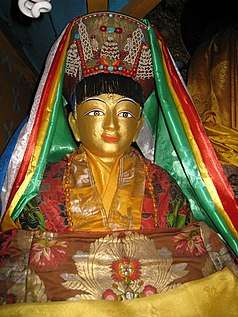Milarepa's Cave
Milarepa's Cave or Namkading Cave is a cave where the Tibetan Buddhist philosopher, and Vajrayana Mahasiddha, Milarepa (c. 1052–c. 1135 CE) spent many years of his life in the eleventh century. It is located 11 kilometres (7 mi) north of the town of Nyalam at Gangka village.[2] It is on the slope below the China–Nepal Friendship Highway and above the Matsang river in Nyalam County, Tibet.[3]
| Milarepa's Cave | |
|---|---|
View overlooking Phelgyeling Monastery at Milarepa's Cave, Tibet | |
| Religion | |
| Affiliation | Tibetan Buddhism |
| Sect | Gelug[1] |
| Patron | Milarepa |
| Location | |
| Location | Gangka village[2], Nyalam County, Shigatse, Tibet |
 Shown within Tibet | |
| Geographic coordinates | 28.2417°N 86.0077°E |
Phelgyeling Monastery

A path leads down from the roadside through the village and down a hillside where there is a small monastery (gompa) named Nyanang Pelgye Ling Monastery, or Phelgyeling which is built around the cave.[4][5] The monastery's assembly hall has the statue, 7 feet (2 m) in height, of Shakyamuni Buddha in the center.
The monastery used to be a Kagyupa but later was converted to a Gelugpa by the 5th Dalai Lama. Later, Phelgyeling Monastery was affiliated with the Gelugpa Sera Monastery in Lhasa.[6][1]
Description of the cave
Milarepa's Cave, which overlooks the entrance to the hidden valley of Lapchi Gang, is entered from the gompa's vestibule. The path is flanked by pilgrim's offerings of decorated stones and sweet-smelling herbs and wild flowers growing all around. The cave itself is kept as a shrine by two monks, guarding a statue of Milarepa enclosed in a glass case. In the cave is an impression in the rock attributed to Milarepa's sitting meditation posture and a hand print said to have been created when Milarepa helped Rechungpa (1083/4–1161 CE), his student, use a boulder to prop up the ceiling. There are images of Milarepa, Tsongkhapa, and Shri Devi, a protectress whose mule is said to have left a footprint in the stone when she visited Milarepa in a vision.[7]
Restoration work within the cave and the monastery was undertaken by artists and craftsmen from Nepal[8] and was financed in the 1970s by the Chinese government.
In art
The cave and the Pelgye Ling temple were the subject of Richard Gere's artistic photo work, Milarepa's Cave, Nyelam Pelgye Ling Temple, Tibet (1993).[9]
Associated caves
There is also a cave associated with Milarepa in Nepal on the Annapurna Circuit at approximately 4,000 metres (13,000 ft) just outside Manang. It is credited to have been the residence of the famous Saint Milarepa during his stay in modern-day northern Nepal. This site also includes a holy spring, gompa, and bow from the local archer who met and tried to kill Milarepa. In the classical songs of Milarepa, he sings of a deer, a dog and a hunter, the chain of causation and compassion. In local tradition, this is the site of this famous tale. The cave is located beyond the gompa, with locals praying from the edge of a glacial moraine in direct line of sight of the cave as its approach is on a steep scree slope.
There are many more caves associated with Milarepa in Nepal. A remarkable one is close to Lar in the Tsum Valley at the border with Tibet, 28.52°N / 85.08°E, alt 3330 m. It features the print in rock of Milarepa's foot. It can be visited and there are two shrines on the site. Buddhist presence in this valley developed around Milarepa's time, as the gompa in Dephu Donma monastery, up the valley, dates back to the 12th century AD.
Footnotes
- "Milarepa Meditation Cave". Tibet Vista. Retrieved 20 January 2020.
The monastery used to be a Kagyupa temple but, since the late 17th century, has been affiliated with the Gelugpa Sera Monastery in Lhasa.
- Bradley Mayhew; Michael Kohn (2005). Tibet. Lonely Planet. p. 192. ISBN 978-1-74059-523-0.
The [Nyalam Pelgye Ling] template is signposted 10km north of Nyalam, at Gangka village.
- Dorje (1999), p. 304.
- Tibet: Highlights in Brief
- Karl-Heinz Everding, "Tibet: lamaistische Klosterkulturen, nomadische Lebensformen und bäuerlicher Alltag ...", p. 260. ISBN 3-7701-4803-7
- Dorje (1999), p. 304.
- Dorje (1999), p. 304.
- Dowman, Keith. 1988. The Power-places of Central Tibet: The Pilgrim's Guide. Routledge & Kegan Paul, London & New York. ISBN 0-7102-1370-0, p. 282.
- Loke, Margarett (November 28, 1997). "Richard Gere 'Pilgrim'". Art In Review. The New York Times. p. E00041.
References
- Dorje, Gyurme (1999). Footprint Tibet Handbook with Bhutan. Second Edition. Footprint Handbooks, Bath, England. ISBN 1-900949-33-4.
- Dowman, Das (1988). The Power-places of Central Tibet: The Pilgrim's Guide. Routledge & Kegan Paul Ltd., London & New York. ISBN 0-7102-1370-0.
- Mayhew, Bradley and Kohn, Michael Tibet. (2005). 6th Edition. Lonely Planet. ISBN 1-74059-523-8.
